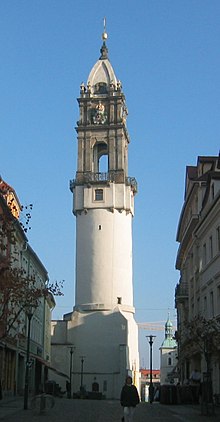Bautzen
| Statistics | |
|---|---|
| State: | Saxony |
| Regierungsbezirk: | Dresden |
| District: | Bautzen |
| Area: | 66.63 km² |
| Population: | 42,199 (01/01/2005) |
| Population density: | 635/km² |
| Elevation: | 204 m |
| Postal code: | 02601-02625 |
| Area/distance code: | 03591 |
| Location: | 51°11′N 14°26′E / 51.183°N 14.433°E |
| Municipal code: | 14272010 |
| Car designation: | BZ
|
| Arrangement of the city: | 24 districts |
| Website: | www.bautzen.de |
Bautzen (pronounced [ˈbautsn̩], ![]() listen, until 1868: Budissin; Upper Sorbian Budyšin; Lower Sorbian: Budyšyn ;Polish: Budziszyn [buˈdʑiʃɨn],
listen, until 1868: Budissin; Upper Sorbian Budyšin; Lower Sorbian: Budyšyn ;Polish: Budziszyn [buˈdʑiʃɨn], ![]() listen; Czech Budyšín) is a city in the east of Saxony, Germany, and capital of the eponymous district. It is located on the Spree River. As of 2003, its population is 42,391.
listen; Czech Budyšín) is a city in the east of Saxony, Germany, and capital of the eponymous district. It is located on the Spree River. As of 2003, its population is 42,391.
Bautzen may be regarded as the unofficial capital of Upper Lusatia, and it is a cultural center of the Sorbs, a Slavic minority.
The first written proof of the city was in 1002. In 1018 the Peace of Bautzen was signed between the German king Henry II and the Polish prince Boleslaus I. The Treaty left Bautzen under the Polish rule. In 1033 the city passed to the Holy Roman Empire, in 1319 to Bohemia and in 1635 to Saxony. During the Middle Ages it was a member of the Six Cities' Alliance of the Upper Lusatian cities of Görlitz, Zittau, Löbau, Kamenz, Lauban and Bautzen.
During the Nazi era there was a subcamp of the Groß-Rosen concentration camp in Bautzen. Ernst Thälmann was imprisoned there before being deported to Buchenwald.
The East German regime kept a prison for opposition members in Bautzen. The prison was called Gelbes Elend ("Yellow Misery") by the people.
In 2002 the city commemorated its thousandth birthday.
Asteroid (11580) Bautzen is named in honor of the city.

History:
- 3rd cen. Eastern Germanic settlement. Excavations show that the Bautzen region was already inhabited in the late Stone Age.
- prob. 958 Erection of Ortenburg Castle
- 1002 First written mention of Bautzen
- 1018 Peace of Bautzen concluded between the early-feudal German city and the Polish duchy; Bautzen region remains under Polish occupation until 1031
- 1076-1085 The city belongs to Upper Lusatia; Ortenburg Castle becomes the administrative centre of this area
- 1084 Wiprecht von Groitzsch moves his residence to Budissin Castle and resides here until 1091
- 1213 Bautzen Town Hall built; construction of the Church of Saint Peter begins
- 1240 Existing city charter of Bautzen first mentioned in written documents
- 1336 Foundation of the Six-City League of Upper Lusatia; besides Bautzen Görlitz, Löbau, Zittau, Kamenz and Lauban (Luban in modern Poland) were members
- 1400 Craftsmen's Rebellion. Bautzen already has more than 5.300 inhabitants and is one of the most important cities in the area of modern eastern Germany
- 1408 Wenceslas, King of Bohemia, in Bautzen, 100 of the rebelling craftsmen were sentenced to death; 14 executions at the Main Market
- 1429 and 1431 Hussites lay siege to the town, but without success.
- 1469-1490 Political allegiance to Hungary (under Matthias Corvinus), after 1490 to Bohemia again
- 1524 Reformation comes to Bautzen; Church of St.Peter becomes an interdenominational church
- 1547 In the so-called "Poenfall", the six cities of the Upper Lusatian League forfeit all of their privileges and holdings to the Emperor, ostensibly because they refused to provide assistance in the Schmalkaldic War (Battle of Mühlberg).
- 1635 Peace of Prague; Upper Lusatia permanenty become part of Saxony.
- 1813 Battle of Bautzen against Napoleon's army.
- 1868 "Bautzen" fixed as official designation. After the name had changed so many times (being called, by turns, Budissin, Budessen, Buticyn, Pautzen, among other forms), the name of the city remains Budysin in Sorbian.
- 1945 Bautzen is declared a fortress in Spring, pitched street fighting until 8 May; heavy casualties, severe destruction
- 1995 Bautzen becomes a major regional administrative centre
Subdivisions:
Here are the subdivisions of Bautzen:
- In the east:
- Auritz
- Jenkwitz-West
- Strehla
- In the south:
- In the west:
- In the southwest:
Twin Cities

- Worms, since 1990
- Heidelberg, since 1991
- Dreux, France, since 1992
- Jablonec nad Nisou, Czech Republic, since 1993
- Jelenia Góra, Poland, since 1993
Sites of Interest:
There are four museums including the Stadtmuseum Bautzen (lit. the Bautzen city Museum) and the Sorbisches Museum, lit. the Sorbian Museum (Sorbian-Lusatian: Serbski muzej).
